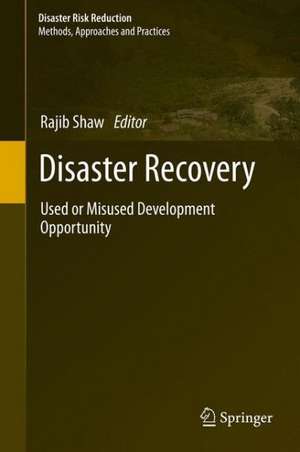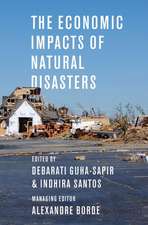Disaster Recovery: Used or Misused Development Opportunity: Disaster Risk Reduction
Editat de Rajib Shawen Limba Engleză Hardback – 8 noi 2013
The book has 21 chapters and is divided into four parts: governance and institutional issues (five chapters), education and learning issues (four chapters), technology and innovation issues (five chapters), and cross-cutting issues (five chapters). The final chapter provides an analysis of the key topics.
The primary target groups for this book are students and researchers in the fields of environment, disaster risk reduction, and climate change studies. The book provides them with a good idea of the current research trends in the field and furnishes basic knowledge about these vital topics. Another target group comprises practitioners and policy makers, who will be able to apply the knowledge collected here to policy and decision making.
| Toate formatele și edițiile | Preț | Express |
|---|---|---|
| Paperback (1) | 796.78 lei 38-44 zile | |
| Springer – 23 aug 2016 | 796.78 lei 38-44 zile | |
| Hardback (1) | 957.75 lei 43-57 zile | |
| Springer – 8 noi 2013 | 957.75 lei 43-57 zile |
Din seria Disaster Risk Reduction
- 18%
 Preț: 796.61 lei
Preț: 796.61 lei -
 Preț: 394.30 lei
Preț: 394.30 lei - 18%
 Preț: 790.46 lei
Preț: 790.46 lei - 15%
 Preț: 654.12 lei
Preț: 654.12 lei - 18%
 Preț: 967.08 lei
Preț: 967.08 lei - 24%
 Preț: 640.27 lei
Preț: 640.27 lei - 18%
 Preț: 1009.16 lei
Preț: 1009.16 lei - 18%
 Preț: 890.54 lei
Preț: 890.54 lei - 18%
 Preț: 942.94 lei
Preț: 942.94 lei - 15%
 Preț: 646.30 lei
Preț: 646.30 lei - 18%
 Preț: 782.24 lei
Preț: 782.24 lei - 18%
 Preț: 898.75 lei
Preț: 898.75 lei - 18%
 Preț: 956.33 lei
Preț: 956.33 lei - 18%
 Preț: 947.50 lei
Preț: 947.50 lei - 15%
 Preț: 643.34 lei
Preț: 643.34 lei - 24%
 Preț: 921.07 lei
Preț: 921.07 lei - 18%
 Preț: 951.91 lei
Preț: 951.91 lei - 18%
 Preț: 894.97 lei
Preț: 894.97 lei - 15%
 Preț: 641.85 lei
Preț: 641.85 lei - 24%
 Preț: 639.86 lei
Preț: 639.86 lei - 18%
 Preț: 790.14 lei
Preț: 790.14 lei - 18%
 Preț: 729.18 lei
Preț: 729.18 lei - 18%
 Preț: 784.13 lei
Preț: 784.13 lei - 18%
 Preț: 783.50 lei
Preț: 783.50 lei - 18%
 Preț: 784.48 lei
Preț: 784.48 lei - 24%
 Preț: 698.99 lei
Preț: 698.99 lei - 15%
 Preț: 642.18 lei
Preț: 642.18 lei - 15%
 Preț: 651.51 lei
Preț: 651.51 lei - 18%
 Preț: 943.57 lei
Preț: 943.57 lei - 15%
 Preț: 649.54 lei
Preț: 649.54 lei - 24%
 Preț: 690.45 lei
Preț: 690.45 lei - 24%
 Preț: 899.52 lei
Preț: 899.52 lei - 18%
 Preț: 962.27 lei
Preț: 962.27 lei - 15%
 Preț: 652.17 lei
Preț: 652.17 lei - 15%
 Preț: 646.75 lei
Preț: 646.75 lei - 20%
 Preț: 587.28 lei
Preț: 587.28 lei - 15%
 Preț: 647.40 lei
Preț: 647.40 lei
Preț: 957.75 lei
Preț vechi: 1167.99 lei
-18% Nou
Puncte Express: 1437
Preț estimativ în valută:
183.27€ • 191.83$ • 152.53£
183.27€ • 191.83$ • 152.53£
Carte tipărită la comandă
Livrare economică 31 martie-14 aprilie
Preluare comenzi: 021 569.72.76
Specificații
ISBN-13: 9784431542544
ISBN-10: 443154254X
Pagini: 448
Ilustrații: XIII, 431 p. 93 illus., 72 illus. in color.
Dimensiuni: 155 x 235 x 30 mm
Greutate: 0.8 kg
Ediția:2014
Editura: Springer
Colecția Springer
Seria Disaster Risk Reduction
Locul publicării:Tokyo, Japan
ISBN-10: 443154254X
Pagini: 448
Ilustrații: XIII, 431 p. 93 illus., 72 illus. in color.
Dimensiuni: 155 x 235 x 30 mm
Greutate: 0.8 kg
Ediția:2014
Editura: Springer
Colecția Springer
Seria Disaster Risk Reduction
Locul publicării:Tokyo, Japan
Public țintă
GraduateCuprins
Post disaster recovery: issues and challenges.- Post-Disaster Reconstruction and Institutional Mechanisms for Risk Reduction: A Comparative Study of Three Disasters in India.- Collaborative governance and disaster recovery: The National Disaster Recovery Framework (NDRF) in the U.S..- Typhoon Morakot and institutional changes in Taiwan.- Institution and governance related learning from the East Japan Earthquake and Tsunami.- Institutional response in education sector in Kesennuma city.- Implication of 2010 Flood in Education Sector in Pakistan.- Role of civil society and its role in formal and informal education as a part of disaster recovery.- New insights of education sector from East Japan Earthquake and Tsunami.- School Based Community Recovery in Kamaishi, Japan.- Post-disaster Housing Reconstruction in Indonesia: Review and Lessons from Aceh, Yogyakarta, West Java and West Sumatra Earthquakes.- Coastal Zone Management in Tamil Nadu, India: Challenges and Innovations.- Post-Aila community recovery innovations and ecological planning.- Incorporating Traditional Knowledge in Post Disaster Recovery to Integrate Climate Change Adaptation and Disaster Risk Reduction.- Technological and Innovative Measures to Improve Flood Disaster Recovery following Mumbai 2005 Mega-flood.- Mangrove management and cyclone risk reduction in Kachchh, Gujarat.- Adaptive and transformative capacities of communities after disaster: The case of oil spills in Guimaras, Philippines.- Environmental management and urban recovery.- Integrated health care as the future of disaster recovery potentials in tohoku Region.- Role of community radio in post disaster recovery: Comparative analysis of Japan and Indonesia.- Disaster recovery as A development vehicle.
Notă biografică
Rajib Shaw is an Associate Professor in the Graduate School of Global Environmental Studies of Kyoto University, Japan. He worked closely with the local communities, NGOs, governments and international organization, including United Nations, especially in the Asian countries. He is currently the Chair of the United Nations Asia Regional Task Force for Urban Risk Reduction. His research interests are: community based disaster risk management, climate change adaptation, urban risk management, and disaster and environmental education. He has published several books in the field of disaster and environmental management. He is also the Chief Editor of Asian Journal of Environment and Disaster Management.
Textul de pe ultima copertă
This book explains key lessons learned from diverse disaster situations and analyzes them within the framework of governance, education, and technology, providing a framework for disaster recovery as a development opportunity. In post-disaster situations, different types of resources are put into the affected region, varying according to technical, financial, intellectual, and community resources. If properly implemented, disaster recovery can change the context of risk-reduction approaches; if not, it can create additional hazards. In some countries, the post-disaster recovery process has even changed the socio-economic and political context of the affected region and country.
The book has 21 chapters and is divided into four parts: governance and institutional issues (five chapters), education and learning issues (four chapters), technology and innovation issues (five chapters), and cross-cutting issues (five chapters). The final chapter provides an analysis of the key topics.
The primary target groups for this book are students and researchers in the fields of environment, disaster risk reduction, and climate change studies. The book provides them with a good idea of the current research trends in the field and furnishes basic knowledge about these vital topics. Another target group comprises practitioners and policy makers, who will be able to apply the knowledge collected here to policy and decision making.
The book has 21 chapters and is divided into four parts: governance and institutional issues (five chapters), education and learning issues (four chapters), technology and innovation issues (five chapters), and cross-cutting issues (five chapters). The final chapter provides an analysis of the key topics.
The primary target groups for this book are students and researchers in the fields of environment, disaster risk reduction, and climate change studies. The book provides them with a good idea of the current research trends in the field and furnishes basic knowledge about these vital topics. Another target group comprises practitioners and policy makers, who will be able to apply the knowledge collected here to policy and decision making.
Caracteristici
The book provides case examples from different parts of the world on recent major disaster events This book analyzes the disaster recovery on three unique components: governance, education and technology Practitioner's perspective is the key source of the book chapters Includes supplementary material: sn.pub/extras





